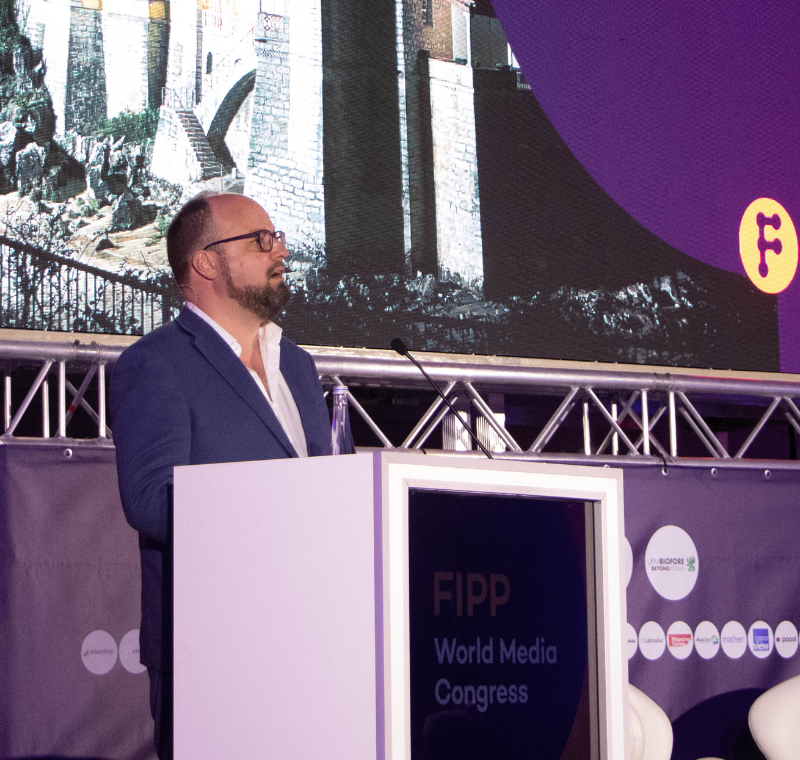Axel Springer’s Hans Hamer: This is how Auto Bild stays front of the grid
Hans will be at the Worldwide Media Marketplace (WMM) and a participant in a panel on brand internationalisation strategies at the FIPP World Congress in Toronto, Canada.
The FIPP World Congress takes place from 13-15 October (the WMM is on 13 October and the main Congress programme on 14 and 15 October). See more on the FIPP Congress website (fippcongress.com).
Tell us about your role within Axel Springer…
My title is the publishing and managing director of the publishing group that covers automotive, consumer electronics and sport. Our big three brands within that division are Auto Bild Group, Computer Bild and Sport Bild. Between those we are publishing something in the region of 50 magazines around the world and we of course have many online and digital activities and profitable websites. We also have other activities. For example, the classic car market is currently booming, so our activities there include classic car rallies and awards, including the most famous – the Golden Steering Wheel. So when you ask me about my role, I would say it is a mixture of roles, comprising publisher – whereby I work with our editors to identify opportunities for growth; a kind of pacemaker, who considers the right time to go to market and how we can get things done; and an anchor man who represents the whole group. Prior to joining Axel Springer in 2001, I worked for nearly 10 years at publishing company Gruner & Jahr. I started my career at advertising agency BBDO in 1990.
Tell us more about the Auto Bild Brand and how it has grown…
The brand was established in 1986 as a magazine title. Now, it is a multi-platform, multi-channel brand. We have a presence in 32 countries, and today the brand includes Auto Bild Allrad, Auto Bild Sportscars, Auto Bild Klassik and Auto Bild TV, to name a few. Auto Bild is the market leader on all channels. In Germany alone our magazines reach 6.5 million readers per month and we have 12.3 million users per month across channels. In terms of my time, I spend around half my time working on Auto Bild, because that division is also a competency centre for the entire Axel Springer Group. Let me give you an example. Within Axel Springer, we of course have Bild, the German tabloid. The paper includes some motoring pages. But the newspaper team barely creates its own motoring content. That content mainly comes out of our division – and in return they give us some promotion. So we are the specialist, the competency centre. In addition to that, it is the biggest and most profitable division, which is why it takes up the bulk of my time. I spend the other 50 per cent of my time split evenly between Sport Bild and Consumer Electronics.
How is the digital world impacting what you do? Presumably, it is easier to enter new markets but, on the other hand, it is a much more competitive marketplace?
Exactly. As you might say, every coin has two sides. The big advantage is reach. The total reach of the Auto Bild family has nearly doubled in the last ten years, so that is good news. Other good news is that we have been able to create a truly integrated newsroom, where every colleague is creating content for print and online. It’s just a question of distribution channels. Of course, every medium has its challenges and specific features to keep in mind. Challenges we face, for example, include how to monetise the digital content. Print is very profitable and we have to consider how we can monetise the reach. We have been very profitable for the past three or four years, and we have good contracts with all the major car manufacturers. But the business model changes and it is not only about content and advertising. It is also about how to generate leads and deliver those to the car dealers and manufacturers. So our business model is changing and we no longer just produce content. We are a transaction business and this is where the biggest growth is to be had. Three years ago, Axel Springer launched a series of paid premium models – such as Bild Plus, a paid/subscription service providing premium content around the Bild tabloid. These are great opportunities. Offering this type of premium content helps create a sense of membership to an exclusive club, and allows us to enhance the user experience.
Do you have competition across the channels for the best content? And how do join all the channels and platforms together?
This is a very important area and we have to make sure we are led by what will make the most money. In terms of whether we put content on the web first or in the magazine first, that depends on what will have the most impact, whether there is a need to deliver quickly and what will make the most money. We have a fully integrated editorial team and the editor-in-chief is responsible for all the channels – the web, the print, the apps, the TV channels – so it is the editor-in-chief who decides what goes where and when. That allows us to plan effectively, including with 360-degree commissioning, and to make sure we are making the most money that we can. We have some interesting conversations among the team members, who want certain content for certain channels at certain times, but we have very good, smart, intelligent characters and I enjoy the fight for content because it shows we have enthusiasm and passion for our products and for the brand. It also means that our ‘new media’ guys are challenging our ‘old print’ guys and it is opening up some new ways of working for everyone.
You’ve seen the Auto Bild brand evolve a lot over the years, from its origins in 1986 to a multi-faceted brand. What excites you going forward?
For me, the thing that motivates me is to have a very competent and effective team with great colleagues. The other thing that excites me is that we have a very entrepreneurial spirit here. ‘Entrepreneurship’ is not just a buzzword for us. We genuinely operate that way. I am allowed to do things my way. For example, in 2007, we didn’t tell anyone what we were doing and then launched Auto Bild Classic Cars (Auto Bild Klassik). It is now a market leader and that was the result of a very entrepreneurial move. We have done a similar thing with a caravan title. That is what drives me and what motivates me. I am excited because the Auto Bild family is growing. And I am excited by the prospect of further segmentation, which is proving very successful for us. Segmentation offers us great opportunity to grow further.
You have been with the business for around 14 years, but I understand your association with Auto Bild began much earlier?
Yes! That is true. During the pre-launch of Auto Bild, in 1985, I was a student and I started my career as a test driver for Auto Bild. When you are testing a car, the very smart guys are the ones who sit in the back, holding on to their legs and just looking forward! I was one of those guys – so my association with Auto Bild actually began long ago, and even before the first issue was published. My hair was a little bit longer, of course, but I remember it well.
What are you looking forward to at the FIPP World Congress later this year?
There are two things I will take away from the Congress. The first is the chance to network with a truly global group of delegates. The second is the opportunity to learn – by sharing my own experiences and hearing the experiences of others. That is about acknowledging the things that don’t work as well as sharing those that do. For me, the most important question to be addressed at the conference is: ‘What are the three key challenges you have identified in your market and how do you respond to them?’
In the last 20 years, the automotive market has changed completely – through digitalization, through connectivity and through technological advances. For example, the engine used to be the most important thing. Increasingly, however, design and brand are getting more and more important. Now we have changes around urban mobility and car-sharing etc. So we have to consider these as challenges to our market and to think about how we respond. Every market has its challenges and that is a great thing to consider. I look forward to hearing about the challenges in other markets at the Congress.
Join Hans and near 80 other international speakers and some 700-800 expected delegates for the FIPP World Congress in Toronto, from 13-15 October 2015.
• See the provisional programme here
• See more speakers here
• See companies that have already registered to be there, here
• To register, click here
If you have questions regarding the FIPP World Congress, contact Claire Jones and/or Natalie Butcher.
For your regular fix of news, Q&As, features, in-depth reports and more, visit FIPP.com and subscribe to our newsletters for regular updates on the Congress and more from the media world. You can also follow us on Twitter | Facebook | LinkedIn | Google+ | Instagram | Pinterest | YouTube for updates.








